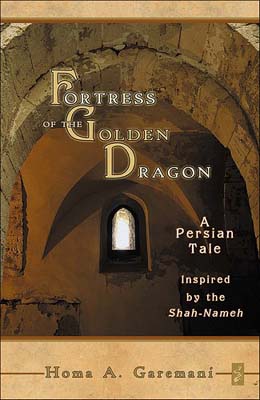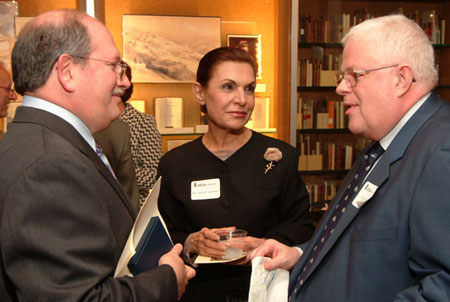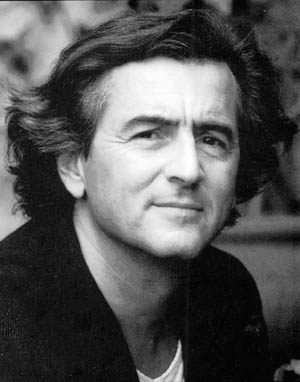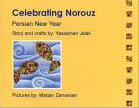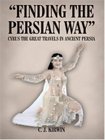|
Fortress of the Golden Dragon: A Persian Tale inspired by the Shahnameh
Tehran, 20 January 2006 (CHN) -- The story of "Fortress of the Golden Dragon" which was inspired by the stories of "Shahnameh" (Story of Kings) found its way to the publication market of England coincident with the 10th century anniversary of creation of "Shahnameh", the most important epic work of Persian language. The Fortress of the Golden Dragon is a mysterious story derived from the stories of Shahnameh. It is among the newest works related to Shahnameh in the publication market of England. Homa Ghahremani, the author of this book who was born and grew up in Iran but resides in the UK now, had published several books before. She has also translated some books on spiritual matters including "Tao d'Ching", the famous book of ancient China which she translated from English to Persian.
Ghahremani dedicated a personal collection of handwritten illustrations in Arabic and Persian languages to the library of UCLA which are preserved in the Middle Eastern and Islamic Studies section of this library. This particular section of the library contains more than 15 thousand handwritten copies in Persian, Arabic, Turkish and Armenian languages. One of these precious copies is "Rubaiyat" of Hakim Omar Khayyam (one of the greatest poets of Iran) in English. The Fortress of the Golden Dragon is a mysterious fiction about the cosmic war between good and evil and light and darkness.
Strong (right) with Homa Garemani (center) and David Hirsch, Jewish and Middle Eastern studies librarian; Mrs. Garemani and her son, Noyan, donated a collection of illuminated Arabic and Persian manuscripts and rare books to the Library. PEARL'S CHAMPION http://www.nowtoronto.com/issues/2003-11-20/books_reviews2.php
Bernard-Henri Levy scores an investigative coup with Who Killed Daniel Pearl? Who Killed Daniel PearL? by Bernard-Henri Levy (Melville House), 454 pages, $38.95 cloth. Rating: NNNNN It was historic in the annals of anti-Jewish hatred – the first filmed ritual slaughter of a Jew. The man in the video, pronouncing his Jewishness before his head is sliced off, was Wall Street Journal reporter Daniel Pearl. He was a liberal and an American Jew who, while working in a totalitarian land, possessed a curious mind. Two years after that snuff film was recorded, French journalist and philosopher Bernard-Henri Levy tries to uncover the real forces that brought Pearl to his imprisonment and martyrdom. He does it very well. BHL, as he's known in France, takes the reader on a gripping journey through Pakistan's labyrinth of secrets and violence. He's a Jewish intellectual following the same path that led to the beheading of his protagonist. At the hotel where Pearl spent the night before his abduction, we learn that it's the headquarters of Islamic militants returning from fighting Indians in Kashmir. The tension builds as BHL makes his way into the grand madrasa in Karachi, a school devoted to the glorification of Osama bin Laden and the war against Jews and the West. There are two main characters in the book, Daniel Pearl and his assassin, the London-raised, highly educated hijacker and Islamic extremist Omar Sheikh, and BHL seems to penetrate the minds of both. He makes a compelling case that the real force behind the killing was rogue elements of the ISI, Pakistan's intelligence service. Levy believes the true danger to the West lies not in Baghdad, but in the Pakistani poverty that bred the al Qaeda cadre and the powerful spy network that helped nurse it into being. This is the best book of investigative journalism since All The President's Men. the end
NEW EDITION: Expedition of Cyrus by Xenophon Not to be confused with Cyrus the Great
The Expedition of Cyrus tells the story of the epic march of the Ten Thousand, an army recruited at the end of the fifth century BC by a young Persian prince, Cyrus, who rose in revolt agains his brother, the King of Persia. After Cyrus' death, the army is left stranded in the desert of Mespotamia, a thousand miles from home. Their long march, across mountains and plateaus to the sight of "The sea! The sea!," and back to the fringes of the Greek world, is the most excititng adventure story to survive from the ancient world. This new translation of Xenophon's most famous work offers a gripping narrative and a unique insight into the character of a Greek army struggling to survive in an alien world. Celebrating
Norouz (Persian New Year) (Paperback)
Lost Wisdom: Rethinking Modernity in Iran (Paperback) by: Abbas Milani
Lipstick
Jihad: A Memoir of Growing Up Iranian in America and American in Iran
(Hardcover)
Finding
The Persian Way: Cyrus The Great Travels In Ancient Persia (Paperback)
Funny
in Farsi: A Memoir of Growing Up Iranian in America
The History of Theater in Iran (Paperback)
In traditional Iranian theater, there was no real difference between high and low culture, although artists attached to the royal court and sponsored by the rich tended to be more competent than those who performed for the public at large. With the exception of religious and narrative drama, written texts were seldom used. The artists—whether comedian, mime, puppeteer, elegist or storyteller performed both in public and private spaces. European theater, with its reliance on a written text and normative rather than improvisatory acting, arrived in 1878 and was part of the modernization process in Iran. It enjoyed a hey-day in the early years of the twentieth century, but has experienced many ups-and-downs since then. Today, it once again enjoys great popularity. At the same time, traditional theatre is being rediscovered, and playwrights are using some of its forms to develop indigenous modern Iranian theatre—a melding of the deep past and dynamic present. Cover painting: A mime dance by a group of professional entertainers accompanied by musicians, ascribed to Mirza Mohammad al-Hoseyni, Iran 1613. Courtesy of Freer Gallery of Art, Smithsonian Institution. About the Author
|

